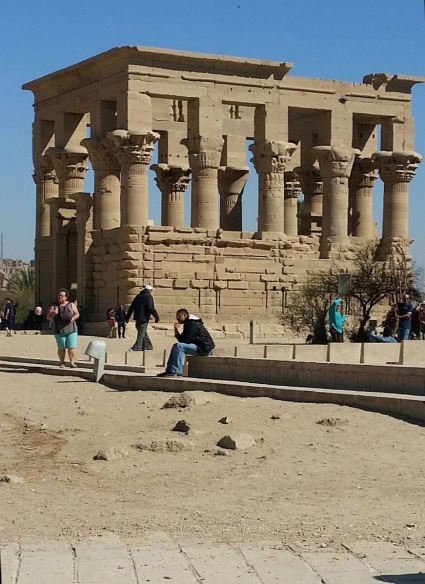March 20, 2019
The Holy Islands of Philae: home to gods and goddesses

For such a tiny island, just 450 meters long and less than 150 meters wide, Philae in Upper Egypt near Aswan has managed to attract more than its share of history and mysteries.
In fact, the original island was frequently drowned by rising Nile waters after the 1902 completion of the Aswan Low Dam and subsequent dam projects that raised the waters even higher.
But the plight of Philae came to international attention some six decades later, when efforts were undertaken to save it in 1960 by the UNESCO Nubia Campaign Project, which also rescued the two great Abu Simbel temples of Ramses II.
This time, the rising Nile waters were caused by the new Aswan High Dam (completed in 1970) and Lake Nasser, the resulting reservoir it formed.
The historic monuments remaining on what was left of Philae, including the ancient Temple of Isis, were salvaged in 40,000 individual pieces and reassembled on the nearby island of Agilkia, just 500 metres away and is similar in size to the original island. Since then, the new island location has also been called “Philae.”
I recently (in February 2019) visited this captivating place for the fourth time.
The mystery that made Philae famous since ancient times is a human story at its core, although the main characters are divines and have been worshiped for millennia.
Isis was revered as the great mother-goddess, of whom it was believed that a single one of her tears, shed over the death of her beloved husband Osiris, causes the annual Nile flood which brings life to Egypt and its people and is credited with resurrecting Osiris.
She prayed for the recovery of her son Horus from sickness and for all Egyptians to be protected from the evil of her brother-in-law Set, who had murdered Osiris. In each case she was successful, but how a single woman was able to do all of this remains a mystery.
No wonder Isis was so loved and worshiped by Egyptians and Nubians alike; her temple and island home of Philae was called the “Pearl of Egypt” and captured the admiration and imagination of countless pilgrims and travelers through the ages.
The island itself was a small, but exquisite earthly paradise, flourishing with abundant plants and palm trees since time immemorial, thanks to fertile soil built up on its granite bedrock from annual Nile silt deposits. Philae was also home to colonies of birds and to river-dwelling crocodiles, who protected it from irreverent intruders, for only priests could live there permanently.
During the Greco-Roman period the sanctuary of Philae outshone many other important and larger centres in Egypt, since it was well established as the center of the cult of Isis (664-525 BC) and was also believed to be the burial site of Osiris.
The Ptolemy Dynasty sought to please Egyptians by building temples on Philae to their most beloved gods and goddesses.
Ptolemy II (285 - 246 BC) began construction of the main Temple of Isis on Philae as well as one to her son Horus, while another was built to her husband Osiris on the nearby island of Bigeh, of which only a portion remains. Other structures on Philae included a small temple to Imhotep (the builder of Zoser’s Step Pyramid at Sakkara) and temples to the Nubian deities Mandolis and Archesnofer.
In her classic memoir A Thousand Miles up the Nile, British writer Amelia B. Edwards (1831-1892) described her 1873 visit to Philae in poetic detail:
“The approach by water is quite the most beautiful. Seen from the level of a small boat, the island, with its palms, its colonnades, its pylons, seems to rise out of the river like a mirage. Piled rocks frame it on either side, and the purple mountains close up the distance. As the boat glides nearer between glistening boulders, those sculptured towers rise higher and even higher against the sky. They show no sign of ruin or age. All looks solid, stately, perfect. One forgets for the moment that anything is changed. If a sound of antique chanting were to be borne along the quiet air – if a procession of white-robed priests bearing aloft the veiled ark of the God, were to come sweeping round between the palms and pylons – we should not think it strange.”
In ancient times, countless pilgrims visited Philae and its neighboring islands, where white-robed priests claimed to have special knowledge of its spiritual mysteries.
Hordes of the faithful could view the image of Isis during spring and autumn festivals held in her honor. At these occasions, the death of Osiris and his resurrection by Isis were vividly re-enacted; Isis was believed to have found the body of her husband locked in a chest and cast into the Nile by his murderous brother, Set.
In modern times the mysterious power of Isis to raise the dead was replaced by a tender love story.
Zahr el-Ward (or “Rose Blossom”), the beautiful daughter of a local ruler, fell in love with a young man called Anas el-Wogud (“Friend of Nature”). But he was considered unacceptable by the girl's father, who decided to seclude her on Philae in the Temple of Isis. He then told Anas falsely that Zahr had gone away.
Anas did not believe him and went in search of Zahr, travelling throughout the country from the Delta to Upper Egypt. Finally, he found that she was on Philae, but crocodiles in the Nile barred his way and he despaired of ever being reunited with her. Then a great miracle happened: one of the crocodiles invited Anas to climb on its back and led him across to the island.
Meanwhile, the beautiful Zahr el-Ward had been planning her escape. Unaware that her lover knew her whereabouts, she succeeded in slipping out of the temple and finding a boat to take her to freedom.
Fortunately, the crocodile bearing Anas and the boat bearing Zahr met mid-stream, where they were joyfully reunited. When the father realized that he could not come between the two lovers, he allowed their wedding to take place on Philae itself, on the rooftop of the Temple of Isis.
While the original Philae temple complex and its detailed artworks had withstood the elements for millennia, repeated flooding and submersions during the first half of the 20th century threatened to obliterate it entirely. Thanks to UNESCO’s concentrated rescue and restoration efforts of the 1960s, these ancient monuments continue to stand in their glory today.








